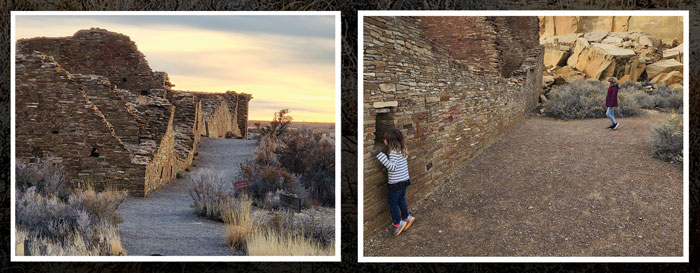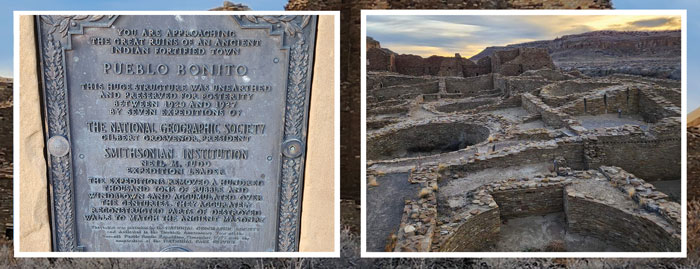
The wind whistles gently through the washes, around sage and juniper and over low mesas. Coyotes howl, and the stars shine brightly in the dark sky after a blazing sunset settles over this World Heritage Site — one of only 24 such sites in the U.S. The roads leading to Chaco Culture National Historical Park are rutted and washed-out dirt or gravel, depending on from which direction travelers are coming, so it is not easy to get to these sacred lands, which are far from the nearest town of Bloomfield, New Mexico. Adventurous travelers to Chaco Canyon can view in the distance the occasional Navajo hogan dotting the landscape. This is a sacred place of the Hopi, Pueblo peoples and Navajo, who believe the spirits of their ancestors live within the canyon.
Today’s world is left behind at the end of the last paved road. Visitors are off the grid, away from modern services or traffic noises. The visitor center has potable water, firewood, required hiking permits and toilets. Primitive camping and RVs under 35 feet long are allowed to camp in a small campground.
The first record of man’s existence in this area, which is arid and prone to seasonal extremes of heat and cold, is A.D. 850, when indigenous peoples made this canyon the center of their civilization. The Chaco people developed over 400 miles of elaborate roads reflecting their worldview of trade and religion and created a complex society. By the early 1100s, Chaco Canyon was a ceremonial and commercial center to dozens of great houses and more than 200 settlements in the region. Shells, macaw remains, copper bells and other items have been found during archaeological digs, proving that this civilization traveled to and from distant lands.

The easiest way to experience Chaco Canyon is to take the Chaco Loop by vehicle, but first, two trails can be accessed from the visitor center. Una Vida is an unexcavated great house with a vast view of the canyon floor’s landscape and a petroglyph panel viewed by climbing the nearby talus slope. A longer hike takes visitors to Wijiji, a great house, built symmetrically with uniform-sized rooms.
The first stop on the loop is Hungo Pavi at the mouth of Mockingbird Canyon. A short hike through the plaza takes visitors to Chacoan Stairway, one of several stairways carved into the surrounding cliffs. Next, rising up from the sand, is the largest of the great houses and the core of the complex, Pueblo Bonito, built in stages over 300 years. A hiking trail east of Pueblo Bonito leads to Chetro Ketl, another great house.

Pueblo del Arroyo, a rare, round, tri-wall structure, has an unobstructed view through the South Gap toward Hosta Butte. Two hiking trail heads can be accessed from this point. The Peñasco Blanco Trail runs through the Chaco Wash with pictographs, petroglyphs and the Casa Chiquita and Kin Kletso sites along the way. At the 2.9-mile marker, the trail splits, so visitors can hike the short distance to Supernova, a pictograph under a cliff overhang. It is believed this may be a record of the Crab Nebula, a star that exploded in A.D. 1054. Kin Kletso’s east wall, as well as other walls within the great houses, may have been situated to confirm the solstices and other celestial events. The other trail winds upward to the Pueblo Alto Complex.
At the base of South Mesa, the Casa Rinconada Community is the largest excavated great kiva in the park. From atop the mesa, one can access Tsin Kletsin, another ruin. As the day ends with the sun setting, it is the perfect spot to view the southern Chacoan roads, the Eastern Mesa and the great houses with their walls aglow.
Sources:
1. National Park Service, U. S. Department of the Interior, Chaco Culture, 2016.
2. Huschke, Kai. 50 Hikes in Northern New Mexico, The Countryman Press, Woodstock, Vermont, 2007.
3. Off the Beaten Path. Reader’s Digest, Pleasantville, New York, 2009.
Written by Virginia Riddle

You must be logged in to post a comment.